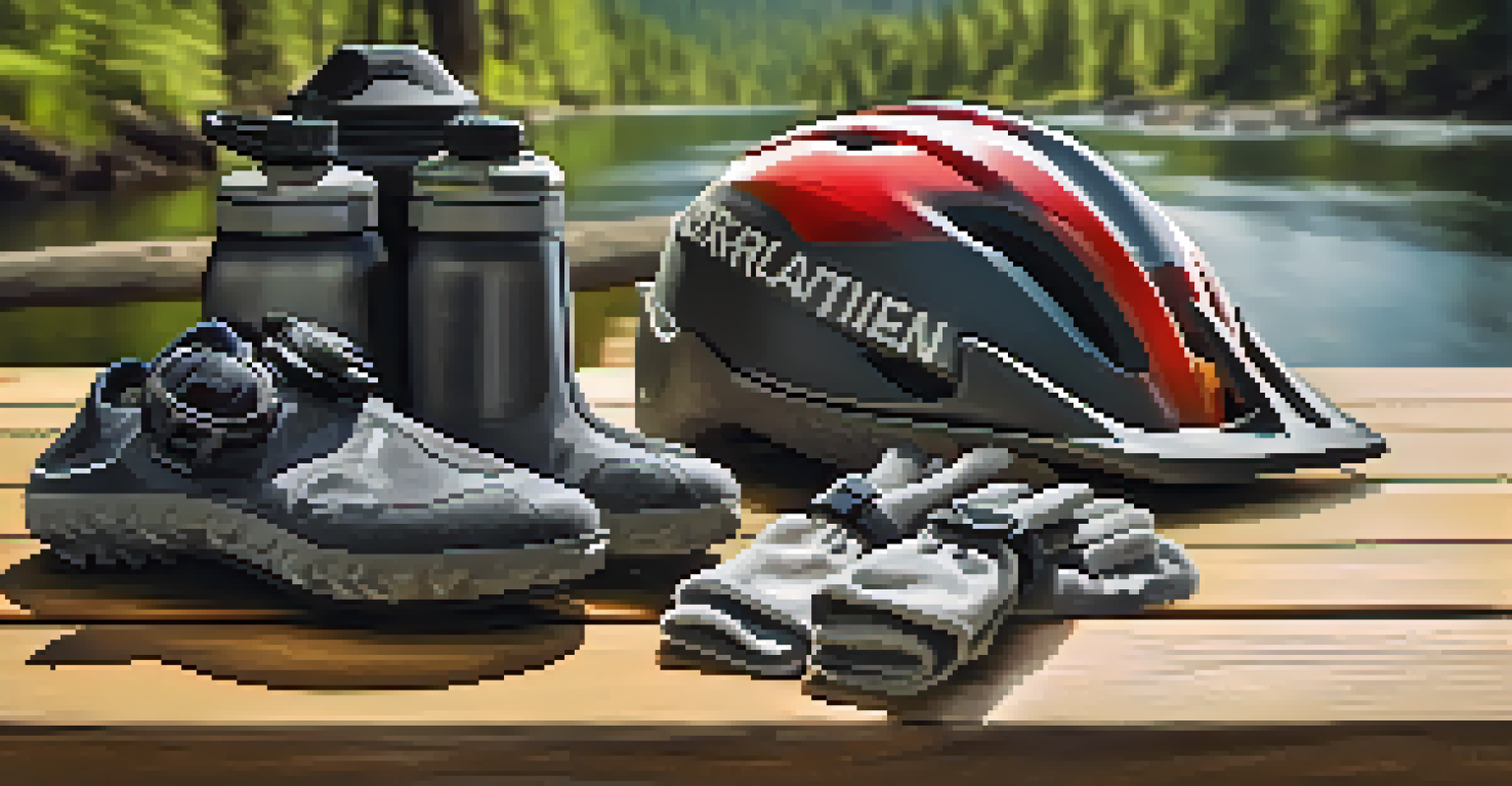Safety Tips for Biking in National Parks and Nature Areas

Know Your Route: Plan Ahead for a Safe Ride
Before you hit the trails, familiarize yourself with the biking routes in the national park or nature area. Use maps or mobile apps that provide detailed information about terrain, elevation, and any potential hazards. Knowing your route allows you to prepare for any tough spots, ensuring a more enjoyable ride.
The best journeys answer questions that in the beginning you didn't even think to ask.
Planning ahead also means checking for park regulations, as some areas may have specific rules regarding biking. Certain trails might be off-limits to cyclists, while others may have designated riding times. Understanding these details ahead of time will help you avoid any unpleasant surprises during your adventure.
Lastly, consider the weather conditions leading up to your ride. Rain can make trails slippery while extreme sun can lead to dehydration. Always check the forecast and prepare accordingly to ensure a safe and enjoyable biking experience.
Wear the Right Gear: Safety First!
Investing in the right biking gear is crucial for your safety and comfort. A properly fitting helmet is non-negotiable; it can significantly reduce the risk of head injuries in case of a fall. Additionally, wear bright or reflective clothing to enhance your visibility, especially in densely wooded areas or during low-light conditions.

Don’t forget about proper footwear! Sturdy shoes with good traction can help you maintain control over your bike and prevent slips on uneven terrain. Padded shorts and gloves can also make a big difference in comfort during long rides, allowing you to focus on enjoying the scenery instead of discomfort.
Plan Your Route for Safety
Familiarizing yourself with biking routes, park regulations, and weather conditions ensures a safer and more enjoyable ride.
Finally, equip your bike with essential safety features such as lights and a bell. Lights are especially important for early morning or late evening rides, while a bell can help alert pedestrians and other cyclists of your presence. These simple additions can enhance your safety and the safety of others on the trail.
Stay Hydrated: Bring Enough Water for Your Journey
Staying hydrated is vital, especially when biking in the great outdoors. The combination of physical exertion and sun exposure can lead to dehydration, which can quickly sap your energy and focus. Always carry enough water to last the duration of your ride, and consider a hydration pack for convenience.
It's not the destination, it's the journey.
As a rule of thumb, aim to drink water regularly, even if you don’t feel thirsty. Taking small sips every 15-20 minutes can help maintain your hydration levels throughout your ride. If you're biking for extended periods, plan to take breaks where you can replenish your water supply.
Don’t overlook the importance of electrolytes, especially on hot days. Consider bringing along electrolyte tablets or sports drinks to help replace essential minerals lost through sweat. This can keep you feeling energized and ready to tackle any trails that come your way.
Be Aware of Wildlife: Respect Nature and Its Creatures
Biking in national parks often means encountering wildlife, which can be both thrilling and challenging. Always remember that you're a visitor in their habitat, so approach wildlife with caution. Avoid startling animals, and never attempt to feed them, as this can lead to dangerous situations for both you and the wildlife.
If you encounter larger animals, such as bears or moose, give them plenty of space and back away slowly. Make noise while biking to alert animals of your presence; this can prevent unexpected encounters. Knowing how to react in these situations is crucial for your safety and the wellbeing of wildlife.
Prioritize Safety Gear
Wearing the right gear, including a helmet and reflective clothing, significantly enhances your safety while biking.
It's also wise to check for any wildlife advisories in the park before your ride. Some areas may have specific guidelines or closures due to animal activity, which can help you avoid potentially hazardous encounters. Staying informed will keep both you and the animals safer during your biking adventure.
Ride with a Buddy: Safety in Numbers
There’s a reason the saying goes, 'safety in numbers.' Biking with a partner or group can significantly enhance your safety while exploring national parks and nature areas. Not only can you look out for each other in case of accidents, but having a buddy can also make the experience more enjoyable and less isolating.
In case of a mechanical issue or injury, having someone nearby can be a game changer. They can assist with repairs or help you get back to a safe area more quickly. Plus, sharing the sights and sounds of nature can deepen your appreciation of your surroundings and create lasting memories.
If you can’t find a buddy, let someone know your planned route and estimated return time. This way, someone will be aware of your whereabouts and can raise the alarm if you don’t return as expected. Always prioritize safety, whether you’re riding with friends or on your own.
Follow Trail Etiquette: Share the Path Responsibly
Biking in shared spaces means being considerate of others on the trail. Following basic trail etiquette can help everyone enjoy their experience while minimizing the risk of accidents. Always yield to pedestrians and be alert for other cyclists, hikers, and horseback riders, ensuring that everyone can safely enjoy the beauty of nature.
When approaching others on the trail, use your bell or call out a friendly warning like 'On your left!' This simple gesture can help prevent collisions and create a more pleasant atmosphere for everyone. Remember, the goal is to share the trail, so be courteous and patient.
Stay Hydrated on Your Ride
Drinking enough water and replenishing electrolytes during your biking journey is essential for maintaining energy and focus.
Additionally, stay on designated paths to protect the environment. Cutting corners or creating new trails can lead to soil erosion and harm local flora and fauna. By respecting the trails, you help preserve the beauty of the park for future generations to enjoy.
Know Your Limits: Listen to Your Body
Understanding your physical limits is crucial when biking in nature. National parks can present challenging terrains that may not be suitable for all skill levels. If you’re new to biking or haven’t ridden in a while, start with easier trails until you build your confidence and stamina.
Pay attention to your body’s signals during your ride. Fatigue, dizziness, or excessive discomfort are signs that you may need to take a break or even turn back. It’s important to challenge yourself, but pushing too hard can lead to injuries or accidents that could have been avoided.

Finally, don’t hesitate to ask for help if you’re feeling overwhelmed. Park rangers and fellow cyclists can offer guidance, and there’s no shame in seeking assistance. Remember, it’s better to enjoy your ride at a comfortable pace than to risk your safety by overexerting yourself.